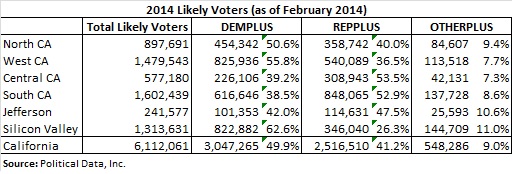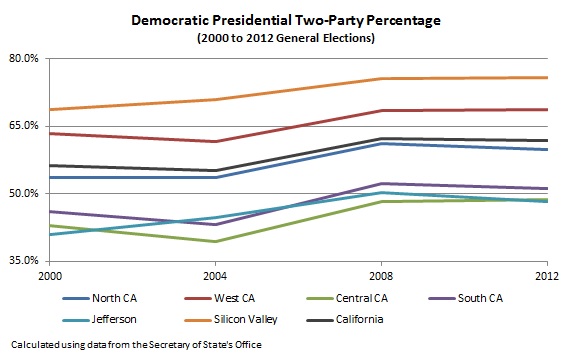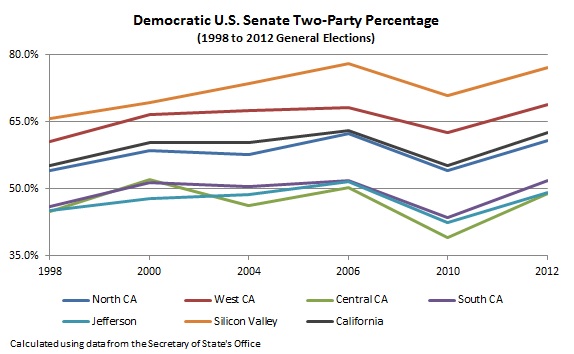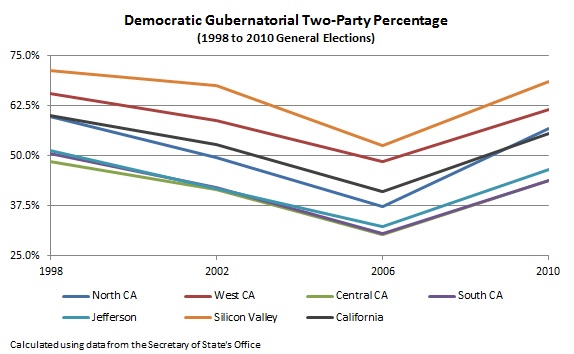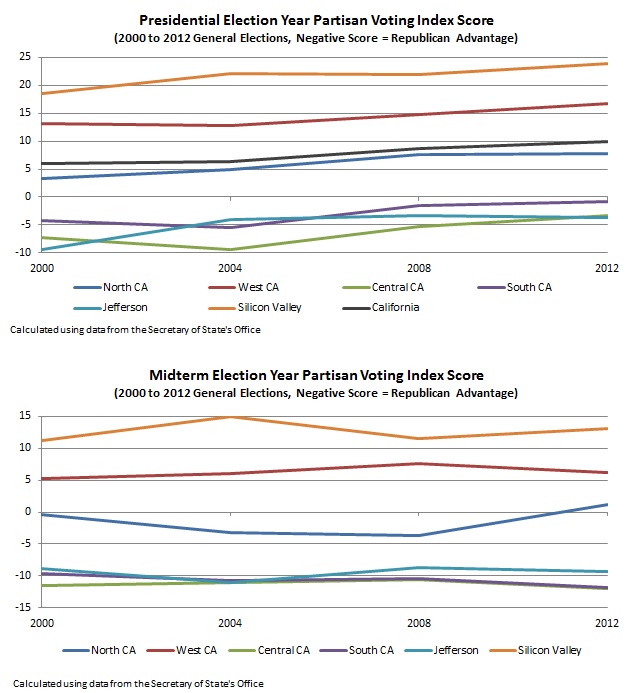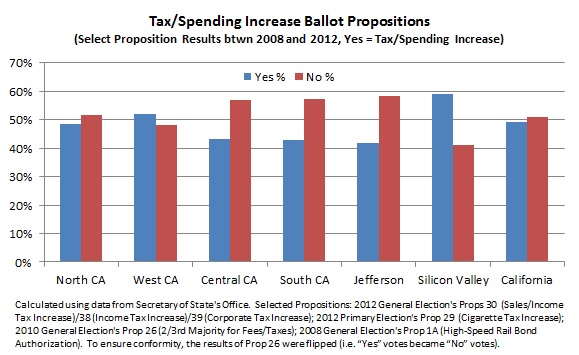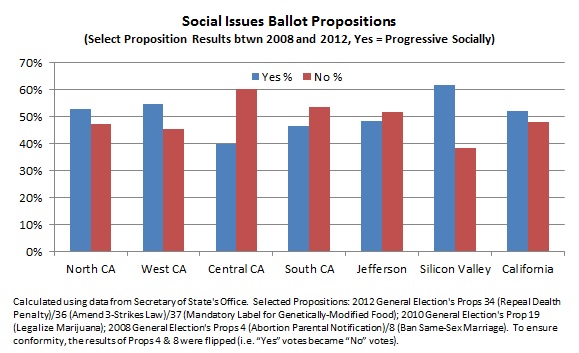*Editor’s Note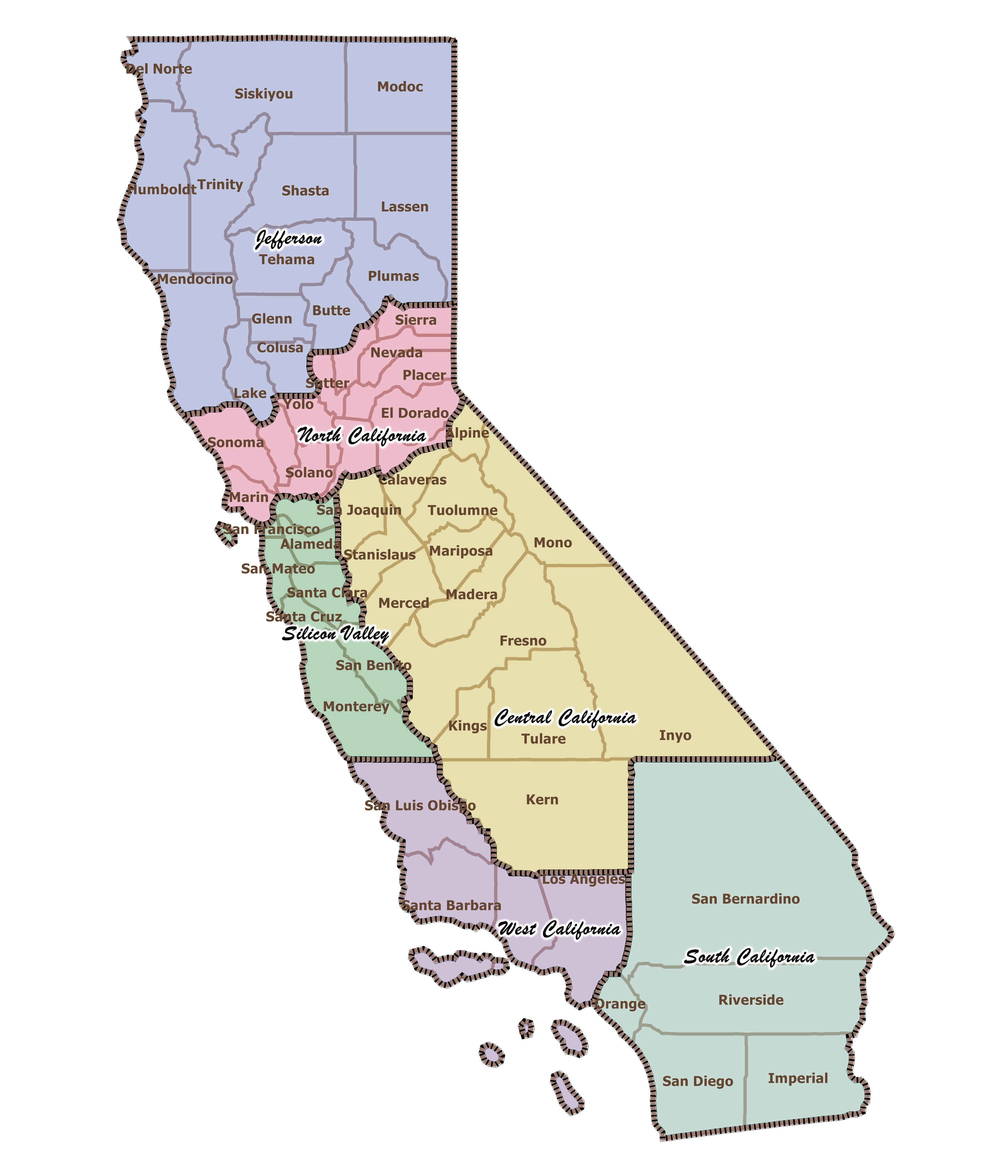 : The first two installments of this series example the possible demographics and economics of Tim Draper’s “Six California’s” initiative, currently in the qualifying stage for the November ballot.
: The first two installments of this series example the possible demographics and economics of Tim Draper’s “Six California’s” initiative, currently in the qualifying stage for the November ballot.
This final installment looks at the politics of partitioned California – what would be the new states of Jefferson, North California, Silicon Valley, Central California, West California, and South California*
Voter Registration/2014 June Primary Likely Voters
At end of last year, some 17.7 million Californians were registered to vote – 44% Democrats, 29% Republicans. Should this initiative pass, Republicans would see registration bumps in Central California (39%), South California (37%), Jefferson (36%) and North California (31%) gaining pluralities in Central and South California and Jefferson. Democrats, on the other hand, would see increases in Silicon Valley (52%) and West California (49%).
In terms of partisanship, North California actually tracks present-day California quite closely, only recently diverging (becoming less Democratic as the state as a whole). Despite being “Republican” states, Jefferson, South and Central California have been trending more Democratic since May 2006.
Looking at likely voters, the Democrat’s 15-point advantage would shrink to a 9-point advantage during the June primary. Republican advantages would increase substantially more in Jefferson, Central and South California than the decrease in Democratic advantages in North and West California and Silicon Valley.
Statewide Election Results & Partisan Voting Scores
Barack Obama won 62% of the California vote in November 2012, an increase of 6 points for the Democratic candidate since 2000. On average, North California tracks California very closely (Democrats underperform by about 2 points). Across the four most recent elections, the Republican presidential candidate would have won Central California in all four elections, Jefferson in three of the four (Obama’s 2008 percentage equaling 50.4%), and South California in two of the four (Obama’s 2012 percentage equaling 51%). If these had been different states, strategy likely would have dictated Republicans to compete heavier in many areas and the Republicans likely would have won Central and South California and Jefferson in all four elections.
North California also serves as a bellwether for California for U.S. Senate elections – since 1992, like the presidential votes, all won by Democrats. Assuming the new Californian senators were in the same election-year “classes” as Dianne Feinstein and Barbara Boxer, Republicans would be very competitive in both Senate seats in South and Central California and Jefferson.
If that were the case, out of the total 12 California seats in the U.S. Senate, it’s reasonable to assume that four would be likely or leaning Republican (Jefferson’s 2 seats, plus one each from Central/South California). Four would be safe or likely Democratic (both of West California’s and Silicon Valley’s). North California’s two seats would be lean Democratic (but winnable for Republicans with a strong candidate and a favorable political trade winds). Central and South California would have one toss-up seat apiece (winnable by either party regardless of national environment). For instance, if in 1998 the Republican could have boosted his/her vote by just 5 points in North California, Republicans could have won the seat. Assuming the GOP could have held the seat in 2004 – a Bush re-election year – Republicans might have extended control into a third term in the first Obama midterm vote (in 2010, the Republican challenger won 46% -- similar to 1998). If Democrats were to sweep the safe, likely, lean and toss-ups seats, Republicans would go from a two-seat deficit (0 to 2) to a net deficit of four (4 to 8). However, if Republicans were to hold the two toss-ups seat and win one of the North California’s “lean Democrat” seat (plausible in non-presidential elections as shown), Republicans could actually gain a net of two seats (7 to 5).
Republicans would, similarly, gain governorships in Jefferson, South California and Central California. Under the right circumstances, Republicans could pick up North California as well. The governorships of West California and Silicon Valley would be reliably Democratic seats, even under very favorable conditions to Republicans.
Another way to examine competitiveness is to look at the Presidential and Mid-term Partisan Voting Score (PVI). These show how partisan a region is compared to either the nation as a whole (based on presidential voting) or the state as a whole (based on gubernatorial voting). For a reference point, toss-up districts are typically R+2 to D+2, lean districts are R+5 to D+5, and likely districts are within 10 points.
In 2012, California increased its presidential PVI to about a D+10 score (up from a D+6 score in 2000). We see again that North California tracked California closely, but underperformed – in 2012, it would have had a D+8 PVI. However, the right Republican could put it in play. South California would be lean Republican but become a toss-up in presidential years; Jefferson and Central California would lean Republican; Silicon Valley and West California would be among the safest Democratic states in the country.
Based on the midterm PVI, South and Central California and Jefferson essentially become safe Republican states. North California would become a Democratic-leaning toss-up state and West California, a likely Democratic state.
Ballot Propositions
While not perfect, ballot propositions can serve as a proxy to understand the policy ideology of the new states. Using a select group of recent, high-profile ballot initiatives (see charts for a list), we can understand a rough snapshot of the policy attitudes the new states would have on fiscal issues and on social issues.
On a whole, most of the new states would be rather centrist when it comes to fiscal issues. Silicon Valley is the real outlier: voting to increase taxes/spending by an 18 point margin overall. South and Central California and Jefferson would be the most averse to increasing the size of government, which further reinforces how a Republican would be able to win over the slightly Republican-leaning South California on a regular basis. Also more likely to disapprove is North California, again creating an opening for the right Republican candidate.
On social issues, we begin to see why California has a liberal persona. While the state is centrist on fiscal issues, it leans decidedly liberal on social policies. In only Central California does the state become more conservative on social issues than on fiscal issues. However, South California and Jefferson maintain their right-leaning nature, while West California moves further to the left and North California diverges from its stances on fiscal issues. In order to maintain the party’s presence in South California and make North California competitive, a Republican would have to be centrist on social issues and be fiscally conservative.
Legislative Delegations
The new California’s would have a total of 52 Congressional districts (North Carolina would actually gain California’s current 53rd seat). West and South California would have the most seats; as such, they would also have the most votes in the Electoral College, each with the same clout as Ohio, North Carolina and Virginia – all presidential battleground states. Republicans would be favored to win Jefferson’s 3 votes, Central California’s 8 votes, and South California’s 17, and would contend for North California’s 7. Had Mitt Romney swept those fictional states in 2012, he would have gained 35 electoral votes – a better showing than the 206 he actually received, but still 29 shy of the 270 goal.
As for California’s congressional delegation, it currently has 33 safe/likely Democratic seats, 12 safe/likely Republican seats and 8 swing seats. Jefferson would only have 1 Representative and that would be a safe/likely Republican seat. Silicon Valley’s entire delegation would be safe/likely Democratic. North California would either be a 3:2 or 4:1 Democratic delegation. Republicans would be at a disadvantage in West California; in South California, partisan control would be determined by two swing seats. Overall, Republicans would gain one safe/likely seat from the new California’s.
With the assumption that all six states adopt California’s current legislative format (40 Senators and 80 Assembly Members), not only would California’s legislative districts become manageable, but they also would become competitive.
Silicon Valley would look a lot like Hawaii, with just a small handful of Republican legislators (it has just 1 safe/likely Republican seat in its Senate). Central and South California and Jefferson all would likely have Republican majorities in their Assemblies and Senates. However, Democrats wouldn’t be completely shut out – they’d likely have majorities in both the Assembly and Senate in North and West California. Still, Republicans would likely be in substantially better positions than the current disadvantage in Sacramento.
In terms of politics, Democrats wouldn’t lose too much. Republicans, on the other hand, would stand to win a lot. Few if anyone gives the Draper initiative a chance to become reality – even if it qualifies for the November ballot and is approved by California, Congress would never ratify the plan for the reason just evaluated: it creates winners and losers.
However, this exercise could succeed in one thing: highlighting the deep disparities – cultural, economic, political – that exist in California. All too often, the temptation is to view California as a homogenous, liberal, wealthy state. But underneath that veneer is a state full of paradoxes that at the very least should be acknowledged by policymakers in the State Capitol.
Follow Carson Bruno in Twitter: @CarsonJFBruno








